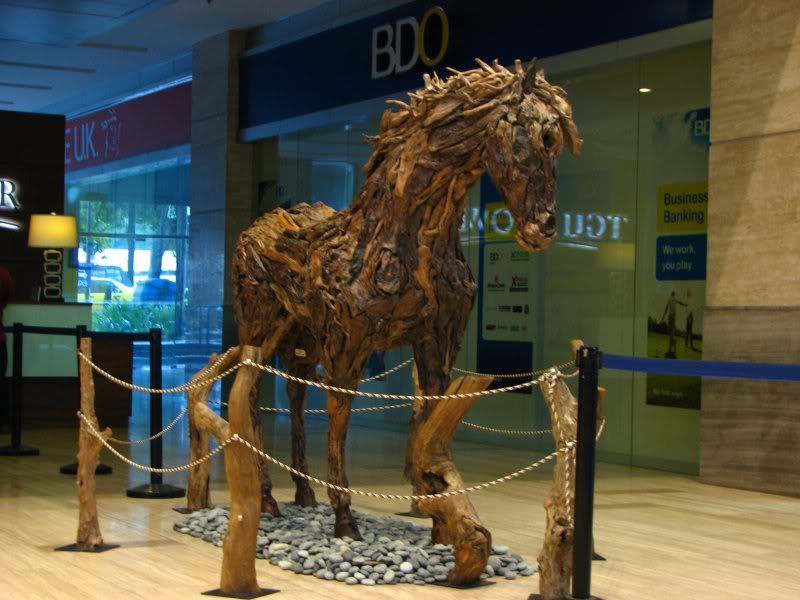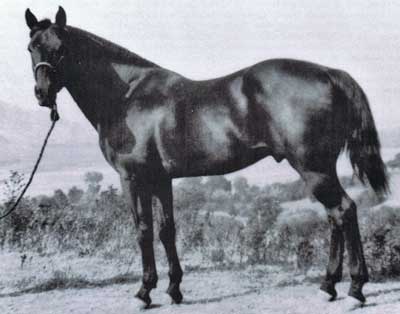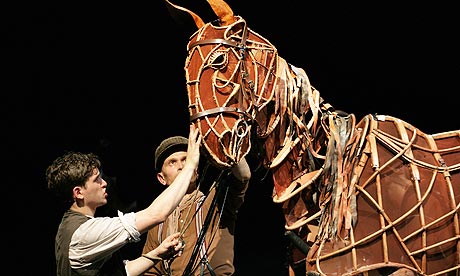On Driftwood Horses and Art Appreciation
by , 07-29-2011 at 09:54 AM (14038 Views)
A stunning horse sculpture made from driftwood greets people upon entering the lobby of the TGU Tower building at I.T. Park, Cebu City. Here is a snapshot I took yesterday. The lighting was dim and I didn't have a tripod, so the image is slightly blurry.
Upon reaching the elevator area and waiting for a ride up, I can't help but overhear reactions of people upon seeing that sculpture (you really can't miss it as you enter the building--the entire thing seems like it wants to trot right into your face). Based on the comments and casual remarks made by these people, most are obviously impressed and/or amazed by the skill and "art" put by the artist into the making of the sculpture. On the other end of the spectrum, I also overheard remarks from people who found the sculpture downright creepy or even revolting.
I've also read blogs and FB posts about this horse sculpture, and noticed that people have been referring to it as a "wooden" horse. Well, the image that pops in my head whenever I hear the term "wooden horse" is the Trojan Horse from antiquity:
It appears to me that most of those who saw the sculpture failed to identify the type of wood being used to make the sculpture. This type of wood is quite special, because of all the physical processes it went through to get its unique look. I'm talking about driftwood:
The reason I'm bringing this up is, I've also overheard people commenting: "Why didn't the sculptor use even/regular/smooth pieces of wood? It would have been less creepier and more realistic."
What most people don't realize is there's an "inside joke" or "deeper meaning" to this sculpture. I'm also going to use this case as an example that, beyond just being able to communicate effectively via a good grasp of English grammar, one has to immerse oneself into the culture of language, in order to somehow acquire a better capacity to appreciate a work of art.
First, let's define the word "driftwood":
Driftwood is wood that has been washed onto a shore or beach of a sea or river by the action of winds, tides, waves or man. It is a form of marine debris or tidewrack. (wikipedia)
Now, let's talk about a real horse:
Driftwood was registered as number 2833 with the American Quarter Horse Association (or AQHA). His stud book entry lists him as a bay horse (meaning stallion in this situation) foaled in 1932, and bred by Mr. Childress of Silverton, Texas. His owners at the time of registration were Catherine A and Chaning Peake of Lompoc, California. His breeding was mostly unknown, with only two lines traceable past the grandparents. Both of those lines traced to Lock's Rondo, however. His second dam was a Thoroughbred mare from Kentucky, although her exact breeding was unknown. His paternal grandsire, the Hobart Horse, is of unknown breeding.
This is a rare photo of the horse named "Driftwood":
So there you have it. These artists who make driftwood horses are likely "playing on the pun" of having a horse made out of driftwood and (perhaps) knew that once upon a time, there lived a famous horse named "Driftwood".
Now the cool thing about Wikipedia is (despite the bashing that it's been receiving from some people who don't really know how to use it), the Disambiguation link/option. This link will redirect you into a page showing ALL the results of your search. If you type in "driftwood" in Wikipedia search, you'd also end up with a disambiguation page that contains not only the driftwood that's found on the seashore, but also realize and know that there was a horse named "Driftwood". If you are not familiar with the nuances of American culture then there would be absolutely no way for you to know about the connection between the medium of the sculpture (driftwood), and a horse.
I want to share two links about driftwood horse artists, for I believe whoever created these sculptures here in Cebu City were inspired by them. http://en.wikipedia.org/wiki/Heather_Jansch or http://en.wikipedia.org/wiki/Deborah_Butterfield (if one of these two aren't actually living in Cebu City already!). Furthermore, the sculpture reminds me of the puppet horse "War Horse" from the play of the same name:
War Horse (play) - Wikipedia, the free encyclopedia
This is the War Horse full-sized horse puppet used in the play:
Great TED Talk from the people who designed and built the War Horse puppets:
Handspring Puppet Co.: The genius puppetry behind War Horse | Video on TED.com
There is more to artwork than meets the eye alone, although I won't argue that the work in itself, without any cultural inference, purely from a skill (how was it done/made?) or technical level, is already quite interesting/amazing. But sometimes, why we say that a work of art is valuable or priceless lies in the fact that there is some deeper significance to it, and sometimes knowing this deeper significance can prove to be useful and insightful for someone, and perhaps, make one appreciate the work even more.
-RODION










 Email Blog Entry
Email Blog Entry

